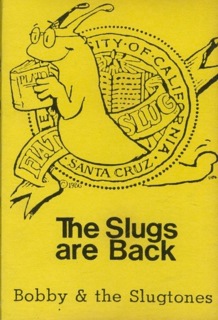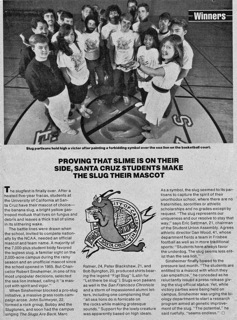Campus News
As the slug rises: Once subversive, UCSC’s beloved mascot turns 25
This year marks the 25th anniversary of UC Santa Cruz’s famous banana slug mascot, a once-subversive symbol on campus. This month, a former chancellor and various alumni looked back on the days when the fate of this character hung on a slender thread of slime.






It’s hard to remember that UCSC’s mascot, the banana slug, was once subversive. For the slug’s earliest fans, rallying behind the mollusk was a mischievous gesture, a thumb in the eye of the status quo.
These days, 25 years after it became the campus’s official mascot, the slug could not be more accepted and beloved. UCSC’s chancellor, George Blumenthal, walks around campus wearing a slug ballcap. His cell phone ringtone is the UCSC banana slug fight song, courtesy of the Austin Lounge Lizards.
Students vie for the chance to wear a newly redesigned Sammy the Slug costume at sports events and campus picnics. Tourists eat peanut butter-filled candy slugs at popular Mackenzies Chocolates in Santa Cruz.
Online, you can find slug pom poms, tall socks, pillows, plush toys, key chains, scarves, mugs, and face decorations. All of this slug paraphernalia can make people forget that this mascot’s future once hung on a slender thread of slime.
A slimy history
Soon after UCSC first opened its doors in 1965, the students started taking hikes through the redwoods. It didn’t take them long to notice the giant, banana-yellow organisms hanging around the ferns and the underbrush.
Native to western North America, these creatures are the second largest land slugs in the world. They descended from marine snails who tried their luck on land 400 million years ago.
Students knew what they were doing when they adopted the slug. If other colleges used fierce mammals to hype their footballs teams, then UCSC, which had no football team, would take up the cause of a slow-moving, slimy creature that had no spine or shell and could mate for eight hours at a time.
“The slug just suited the campus so well–its symbiotic relationship with the redwoods and its nonviolent Gandhi-an characteristics,” said Marc Ratner (Cowell ’87, linguistics).
Ratner would later give the slug a popularity boost by designing the “Fiat Slug” logo–showing a cartoon slug wearing glasses while reading Plato. (“Fiat Slug” means “Let there be Slug” in Latin.) But without a series of events that began in 1980, it’s possible the slug would have merely enjoyed a long life as an underground mascot at UCSC.
Turning point
That was the year Chancellor Robert Sinsheimer brought the campus into the National Collegiate Athletic Association as a Division III school for the first time. Until then, UCSC had unofficial sports “clubs” but no NCAA teams.
Sinsheimer felt that Division III status was a good compromise; it enabled UCSC to compete while holding on to its “traditional low-key approach to athletics.”
NCAA Division III-affiliated colleges did not offer full sports scholarships to student athletes. However, they were expected to have an official mascot, and UCSC was no exception. In 1981, a group of student athletes pushed for the sea lion; Sinsheimer supported their choice.
The matter seemed settled, but the slug cause would not die. Students kept showing up to basketball games, and yelling “Slime ’em!” and “Go slugs!”
In 1986, the newly formed Student Union Assembly voted to put the mascot issue on a campuswide ballot measure.
Eric Satzman (Cowell ’87, sociology), the SUA president at that time, recalls that it was a non-binding resolution. The administration, not the students, had the final say about the mascot issue. Still, Satzman was confident the slug would prevail and at least the students’ preference would be made clear.
“The slug represented the hearts and minds of the students and the way they perceived UCSC as a unique institution,” he said. Satzman added that he had nothing against the “poor little sea lion.”
In conjunction with the SUA measure, a number of students rallied for the cause. Satzman, along with fellow students John Sulmeyer (Cowell ’87, history) and Jon Spivak (Cowell ’87, language studies), formed a rock group, Bobby and the Slugtones, which released a single called “the Slugs Are Back.” The “Bobby” part of their name was a winking reference to Chancellor Sinsheimer.
“We recorded it in my room,” said Sulmeyer, who sang lead vocals. “I tweaked my voice electronically because I was trying to sound like a slug. Obviously, it was complete silliness.”
But the song resonated. A major radio station in San Francisco played it. “It definitely added to the (slug) hysteria,” Sulmeyer said. “Eric was getting calls from National Public Radio.”
The song’s popularity, and the national publicity surrounding the slug-versus-sea lion debate, galvanized the campus. Radio stations across the country weighed in. So did national newspapers and magazines from People to Audubon.
Meanwhile, at UCSC, the slug continued to grow in popularity. Alumni sent letters supporting the slug. The results of the student vote were clear: A five-to-one majority favored the banana slug.
Administrative hesitance
Initially, Sinsheimer expressed his reluctance to embrace the student choice for mascot.
Though he is a distinguished scientist known for his breakthroughs in genetic research, Sinsheimer received a very different kind of publicity when he wrote, in a witty and spirited statement to a campus newspaper, that the sea lion had plenty of “spirit and vigor,” while dismissing the slug as “spineless (ipso facto), yellow (cowardly), sluggish (slow of foot [?]), and slimy (enough said).”
Later, after Sinsheimer bowed to the vote, and the slug became the official face of UCSC, he made it clear he had no personal animus toward the moist, yellowy mascot.
On the invitations to his retirement reception in June 1987, he included a logo that must have taken some of his colleagues by surprise. It showed a cartoon banana slug and sea lion embracing each other with smiles on their faces.
“The students have the greatest interest in the mascot, so I agreed to accept their choice, which was overwhelmingly the banana slug,” he said in a recent interview. “I am fine with that. It is amusing, and the artists have drafted it into a rather fetching icon.”
The slug mascot may very well be the most recognizable image associated with UC Santa Cruz. John Travolta helped the banana slug cause immeasurably in 1994 when he wore a UCSC T-shirt, with Ratner’s Fiat Slug logo, in Quentin Tarantino’s hit movie Pulp Fiction.
These days, members of UCSC sports identify as slugs.
But it doesn’t stop there. Even undergraduates who don’t play sports, and alumni who live far away from UCSC, identify with the slimy yellow mollusks.
“To this day,” said Marc Ratner, “I think of myself as a slug.”